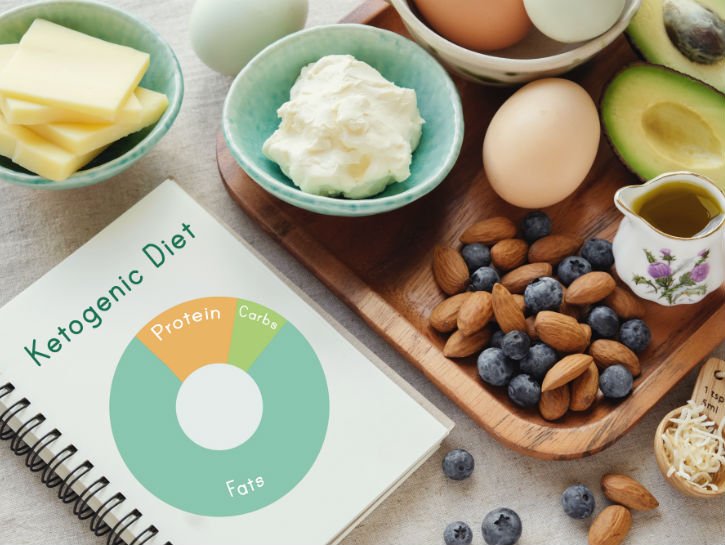The ketogenic diet, or “keto diet”, is a low carb diet that produces ketones in the liver that are used as energy in lieu of glucose. This is done by having an extremely low carb intake while having a diet that includes 80% fats and moderate levels of protein. This allows you to reach a constant state of ketosis — when fat is released and used for energy. The usage of fat allows for accelerated weight loss.
Potential Benefits Of A Keto Diet
On top of the weight loss benefit, a keto diet lowers your body’s blood sugar levels due to the lack of carbs, leading to a healthier lifestyle for people with diabetes as well as decreasing the risk of contracting Type II diabetes. The keto diet has also been known to be beneficial for children with epilepsy, although the diet must be closely monitored by doctors.
Other benefits of a keto diet include an increase in focus, an increase in energy and a more controlled appetite.
Potential Negatives Of A Keto Diet

The beginning of a keto diet can be difficult as the body adjusts to a lack of glycogen in the body — this can leave people feeling dizzy, lethargic and with an overall lack of energy. The restrictive nature of the diet can be a turn off for many people as well, as preparation and planning is needed whenever going to a social outing or a restaurant to ensure it fits the dietary needs.
Athletes who participate in sports with a high anaerobic component will suffer greatly on a keto diet as the energy output given off by ketones are much smaller than the energy given off by glycogen.
Switching to the keto diet can lead to what’s known as the “keto flu“. The keto flu symptoms include headaches, cramps and general fatigue. It’s caused by the drastic change in diet and your body’s adaptation to the new way of eating. If you come down with the keto flu, it’s important to drink fluids rich in electrolytes and if you’re really struggling with the symptoms, you can lower your carb count gradually instead of going cold turkey.
How To Start On A Keto Diet
When you’re ready to start on a keto diet, clear out that pantry and get ready to be active.
What To Eat

The success of your keto diet will depend almost entirely on what you eat. The keto diet will have you indulging in lots of foods high in fat and moderate in protein while completely avoiding carbs. That means you won’t be grains such as eating pasta, rice, and corn. It’s also important to avoid sugary drinks, starch-heavy vegetables such as potatoes and winter squash, and fruits such as bananas, apples, and oranges.
Getting Enough Fats
You want to make sure your diet is at least 75% fat on a keto diet. Saturated fats will be key in this diet but make sure to avoid trans fats as they don’t break down well in the human body. Cooking with coconut, olive, or avocado oil will be crucial in getting those essential fats into your system.
Dairy products such as whipping cream, greek yogurt, cream cheese and heavier cheeses such as brie, cheddar, and mozzarella are all great for getting fat into your system but be careful of the carb content in the more commercial dairy products. Vegetables are important in your diet but avoid any vegetables that are known to have high sugar contents. Spinach, kale and green peppers are great examples of good vegetables on a keto diet.
Nuts are a necessary addition to your diet to ensure you’re getting the required amounts of fat. Focus on almonds, pecans, hazelnuts and nut butter while avoiding walnuts and pine nuts — they have a high carb count and will throw you off ketosis.
Protein
You’ll still need a moderate amount of protein on a keto diet. The best sources of protein on said diet are fattier cuts of red meat like a ribeye steak, for example. Dark meat chicken is a great source of fat and preferred over white meat. Fish can be an excellent source of protein, as well as eggs, liver, and shellfish.
Physical Activity

The keto diet can leave you with an electrolyte imbalance and dehydration, so take care when exercising on the keto diet — if you feel dizziness, stop immediately and find out the problem. Physical activity will be difficult in the first few weeks of starting the diet and anaerobic exercise can be very difficult to do with the absence of carbs, but aerobic exercises can be done to near maximum performance.
Side Effects Of Keto
Aside from the aforementioned side effects such as fatigue, headaches and the keto flu, going on the keto diet can leave you with an elevated heart rate, bad breath and body cramps. It’s important to drink lots of water, absorb those crucial electrolytes and to start slow with the low carb intake and physical activity. It’s highly recommended to do plenty of research and to consult a doctor before starting on the keto diet!
